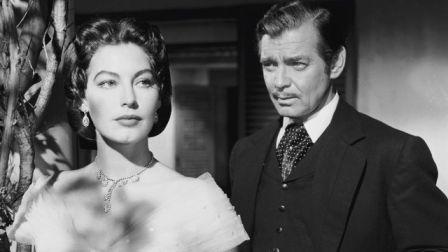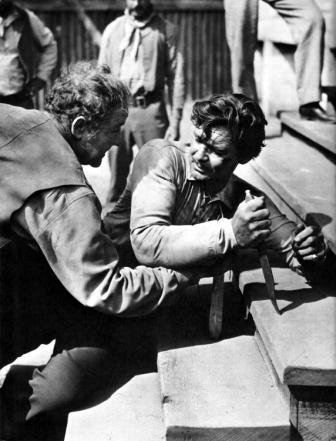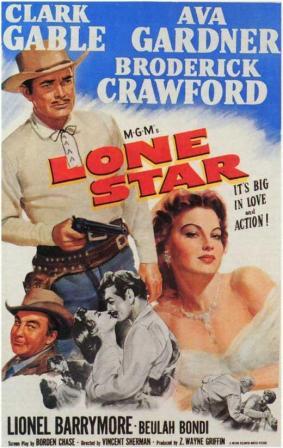“A woman like you isn’t going to kiss more than one man like this!”
Surprisingly, 1952’s Lone Star was Clark Gable’s first real foray into the Western genre. And MGM spared little expense (except one) in bring it to the big screen. They brought together an outstanding cast, adding Ava Gardner, Broderick Crawford and Lionel Barrymore to the film. It’s one of the few with three winners of the Best Actor Oscar to appear in the same film (Gable, Crawford and Barrymore).
MGM takes it further with outstanding scenery, sets and a better than average score from journey David Buttolph. For it’s era, Lone Star is remarkably violent, with more action than two or three other films. The only thing MGM seems to have overlooked is Technicolor, which would have made the picture that much more appealing.
The plot is a bit convoluted, telling of wheeling and dealing on the question of whether Texas will join the United States or continue as an independent republic. Gable is cattleman Devereaux Burke, an emissary from former President Jackson (Barrymore) to dissuade Sam Houston from going it alone and abandoning the United States. Almost immediately along the way Burke encounters his nemesis, Texas state Senator Thomas Craden (Crawford) who is adamantly opposed to joining the Union. Not only do they disagree on Texas’ future, but they also battle less openly for the affections of Martha Ronda (Ava Gardner).
 Though action packed, the plot gets bogged down a bit with the romantic musings between Gardner and Gable. And the overall storyline of the potential annexation falls relatively flat on most Americans, though of course more Texans will be aware of the rough similarities the plot has to actual history. In any case, the film was a fairly large success for MGM on its release.
Though action packed, the plot gets bogged down a bit with the romantic musings between Gardner and Gable. And the overall storyline of the potential annexation falls relatively flat on most Americans, though of course more Texans will be aware of the rough similarities the plot has to actual history. In any case, the film was a fairly large success for MGM on its release.
Regardless of the plot, it’s hard to find much fault in the cast of Lone Star. Gable’s still got it into his fifties, though at times he seems to be Rhett Butler recast with spurs. One sees that he could have been a bigger Western star had he come to the genre earlier, though he did a few Westerns late in his career following Lone Star.
Broderick Crawford is – well he’s Broderick Crawford here, all full of bluster as he usually is. Sadly, his character is afflicted with near insipid levels of stupidity by the script. One minute his men are blasting away at Gable’s and the next they are fighting side by side for the greater good of Texas.
Ava Gardner also is better than usual in Lone Star, showing a bit more range than she’s usually permitted. Here she is the editor of the local paper though she’s still the typical third leg of a love triangle.
 Lionel Barrymore in his final film appearance is good if sparsely used, appearing in only two scenes. Reprising an earlier portrayal of Jackson in 1936’s The Gorgeous Hussy, he’s full of the eye rolls and exaggerated hand motions which he increasingly leaned upon in his later films. Here he smashes a vase (worth $17) with his walking stick in a fit of frustration.
Lionel Barrymore in his final film appearance is good if sparsely used, appearing in only two scenes. Reprising an earlier portrayal of Jackson in 1936’s The Gorgeous Hussy, he’s full of the eye rolls and exaggerated hand motions which he increasingly leaned upon in his later films. Here he smashes a vase (worth $17) with his walking stick in a fit of frustration.
Though not a great film by any means, Lone Star is quite entertaining and may have even inspired a few latter films of the genre. Though perhaps unlikely, when Crawford and his men charge Gable’s force, it’s oddly reminiscent of the Newton’s Station attack sequence in John Ford’s 1959 film The Horse Soldiers. You wonder if David Buttolph (who worked on both films), had a role to play there.
Of course, he surely didn’t but the scenes still have the same look and feel.
[embedyt] https://www.youtube.com/watch?v=l21ZK2EiqxI[/embedyt]
